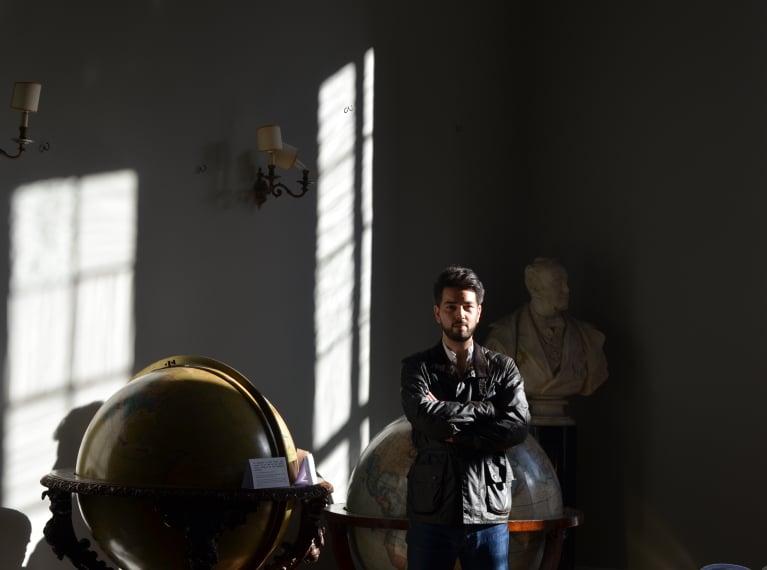
Academic Makoto Takahashi, who has earned an international reputation for his research into the Fukushima Daiichi nuclear power plant meltdown in Japan, has curated an exhibition on the disaster, which is being shown at the Royal Geographical Society.
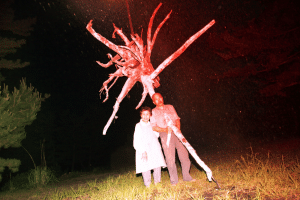 The exhibition, which runs until 23rd December, marks the tenth anniversary of the meltdown, and of the earthquake and tsunami that triggered it. Visitors have included a party of A-level Geography and Art students from QE: Makoto treated them to a lecture on the exhibition and also gave them a guided tour.
The exhibition, which runs until 23rd December, marks the tenth anniversary of the meltdown, and of the earthquake and tsunami that triggered it. Visitors have included a party of A-level Geography and Art students from QE: Makoto treated them to a lecture on the exhibition and also gave them a guided tour.
Makoto (OE 2003–2010) is the youngest-ever lecturer at the Munich Centre for Technology in Society (MCTS), part of the Technical University of Munich, a position he gained in 2019. A previous holder of a Science and Technology Studies Fellowship at Harvard, he will be returning to the Harvard Kennedy School of Governance as a Fulbright-Lloyd’s Fellow in early 2022.
For the past eight years, his work has focused on examining how expert authority is claimed in conditions of low public trust. Considered somewhat niche when Makoto first proposed it as his field of study in 2013, its relevance became apparent in 2016 with the election of President Donald Trump.
“In fact, I was at an OECD Nuclear Energy Agency event in Fukushima prefecture on the day that Trump was elected,” he says. “The shock was palpable. And the parallels between the crisis of confidence that Japanese experts faced following ‘3.11’ [the earthquake and tsunami took place on 11th March 2011] and the ‘post-truth’ political moment were clear.”
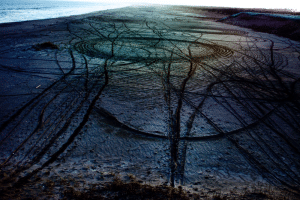 The exhibition, entitled Picturing the Invisible, sees his research interests coming together with his longstanding involvement with the London art scene: while in the Sixth Form at QE, he took part in in the Royal Academy’s attRAct programme and in the Louis Vuitton Young Arts Program; he has also been an Event Manager at the OPEN Ealing community art gallery.
The exhibition, entitled Picturing the Invisible, sees his research interests coming together with his longstanding involvement with the London art scene: while in the Sixth Form at QE, he took part in in the Royal Academy’s attRAct programme and in the Louis Vuitton Young Arts Program; he has also been an Event Manager at the OPEN Ealing community art gallery.
It features the work of six photographers complemented by a series of short essays from policymakers, experts, and activists. The contributors include some “wonderful artists and essayists”, says Makoto, such as: Lieko Shiga, a photographer based in Kitakama, a village hit hard by the tsunami; Yoi Kawakubo, who buries silver halide film in the contaminated soils of Fukushima’s exclusion zone to produce a powerful series of abstract images, and Sir David Warren, British Ambassador to Japan, 2008–12.
A collaboration between the RGS and the Munich Centre for Technology in Society, the exhibition has secured coverage in publications including The New Statesman and The British Journal of Photography.
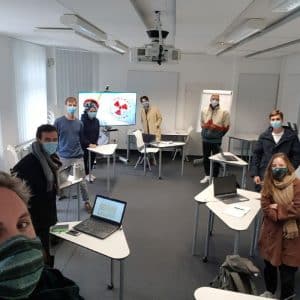 In preparing for it, Makoto says he has been committed to pedagogic innovation to benefit students disadvantaged by the impact of Covid-19 on higher education. “The pandemic has robbed students of so much of the normal university experience, so it’s even more important than ever to innovate new modes of engagement. In this spirit, I integrated preparations for Picturing the Invisible into my teaching at MCTS. Seven students from the Responsibility in Science, Engineering and Technology course have been involved in every step of the planning and [have shared] their perspectives on the works in the exhibition programme, alongside seasoned policymakers, activists, and experts.”
In preparing for it, Makoto says he has been committed to pedagogic innovation to benefit students disadvantaged by the impact of Covid-19 on higher education. “The pandemic has robbed students of so much of the normal university experience, so it’s even more important than ever to innovate new modes of engagement. In this spirit, I integrated preparations for Picturing the Invisible into my teaching at MCTS. Seven students from the Responsibility in Science, Engineering and Technology course have been involved in every step of the planning and [have shared] their perspectives on the works in the exhibition programme, alongside seasoned policymakers, activists, and experts.”
After leaving QE, Makoto took a First in Geography at Cambridge, winning the M T Dodds and Rowley Mainhood Awards for academic excellence during the course of his degree. He went on to gain his MPhil and PhD from Cambridge, where his doctoral studies were funded by the Economic and Social Research Council.
While there, in addition to lecturing, co-ordinating undergraduate groups and working with the university’s Communications Office to produce podcasts for a non-specialist audience, Makoto also served as the secretary of the Mixed Martial Arts Society (CUMMA).
In 2017, he spent three months as a Visiting Research Fellow at Tokyo’s Waseda University, where the proximity to Fukushima proved valuable. “I had the opportunity to interview notable public figures in the Fukushima debate, making regular trips to Fukushima prefecture itself.”
His thesis, The Improvised Expert: Performing Authority after Fukushima (2011–2018), drew upon his own extensive ethnographic fieldwork conducted in Japan; it won the American Association of Geographers’ Jacques May Thesis Prize.
He has presented his work at the Maison Francais d’Oxford (at the invitation of the French Ministry for Europe and Foreign Affairs), at the British Embassy in Paris, CEPN (Le Centre d’étude sur l’Evaluation de la Protection dans le domaine Nucléaire – a non-profit radiological protection organisation) and gave a paper at a conference organised by the International Commission on Radiological Protection to examine the lessons of the Fukushima Daiichi disaster.
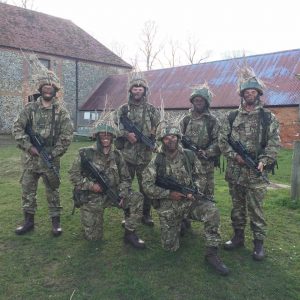 During his schooldays, Makoto threw himself into all that QE had to offer. He was involved in debating, was the leader of the second violins in the Chamber Orchestra and was in the waterpolo team.
During his schooldays, Makoto threw himself into all that QE had to offer. He was involved in debating, was the leader of the second violins in the Chamber Orchestra and was in the waterpolo team.
Today, he is still in contact with School friends Eigo Takeda, who read Mathematics at Cambridge before taking up consultancy work in Japan, and Evgeny Slavin, who works in venture capital in Cambridgeshire.
Having previously worked towards a commission with the British Army Reserve, he has had to pause his involvement with the reserves while working outside the UK.
